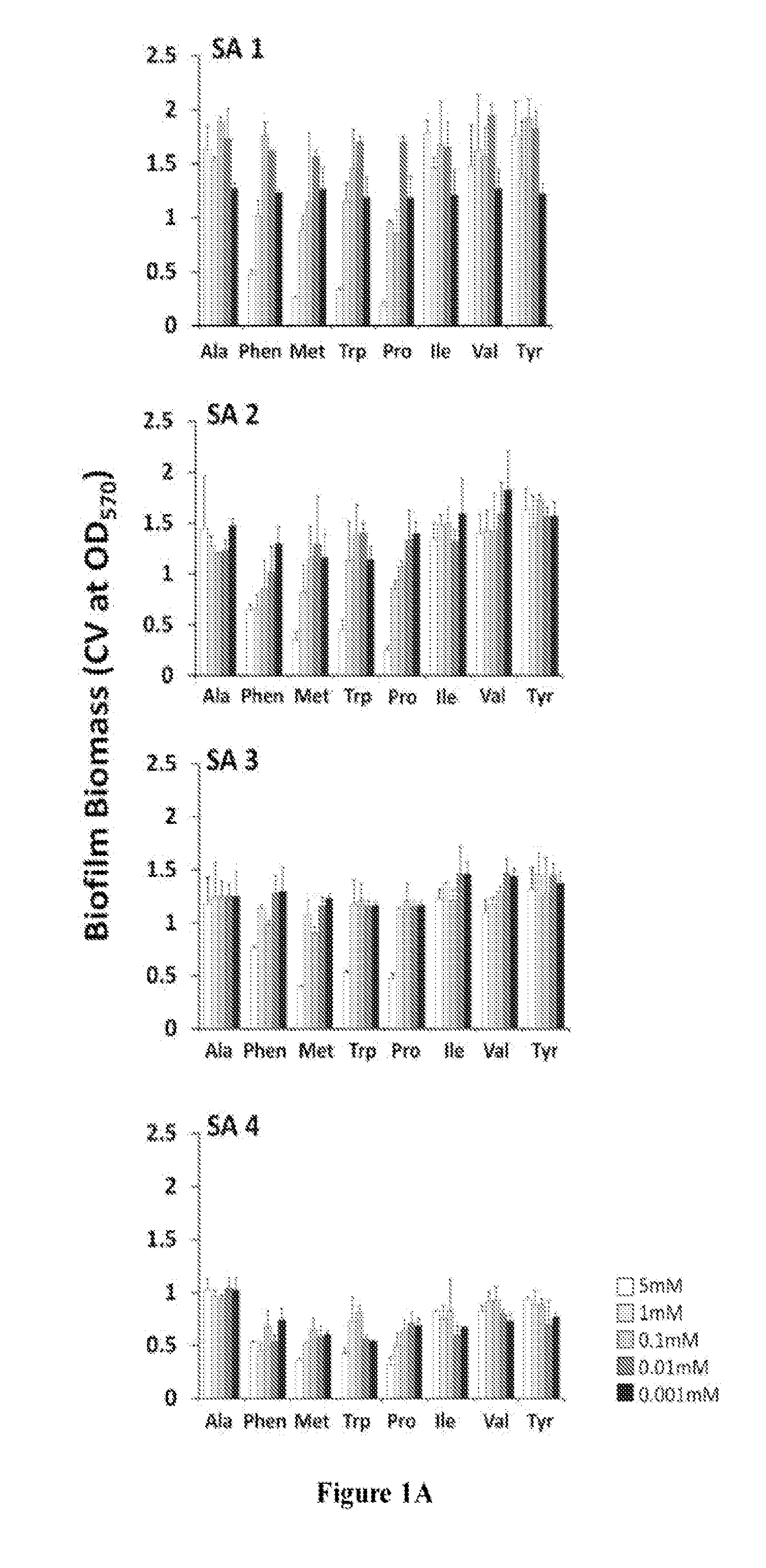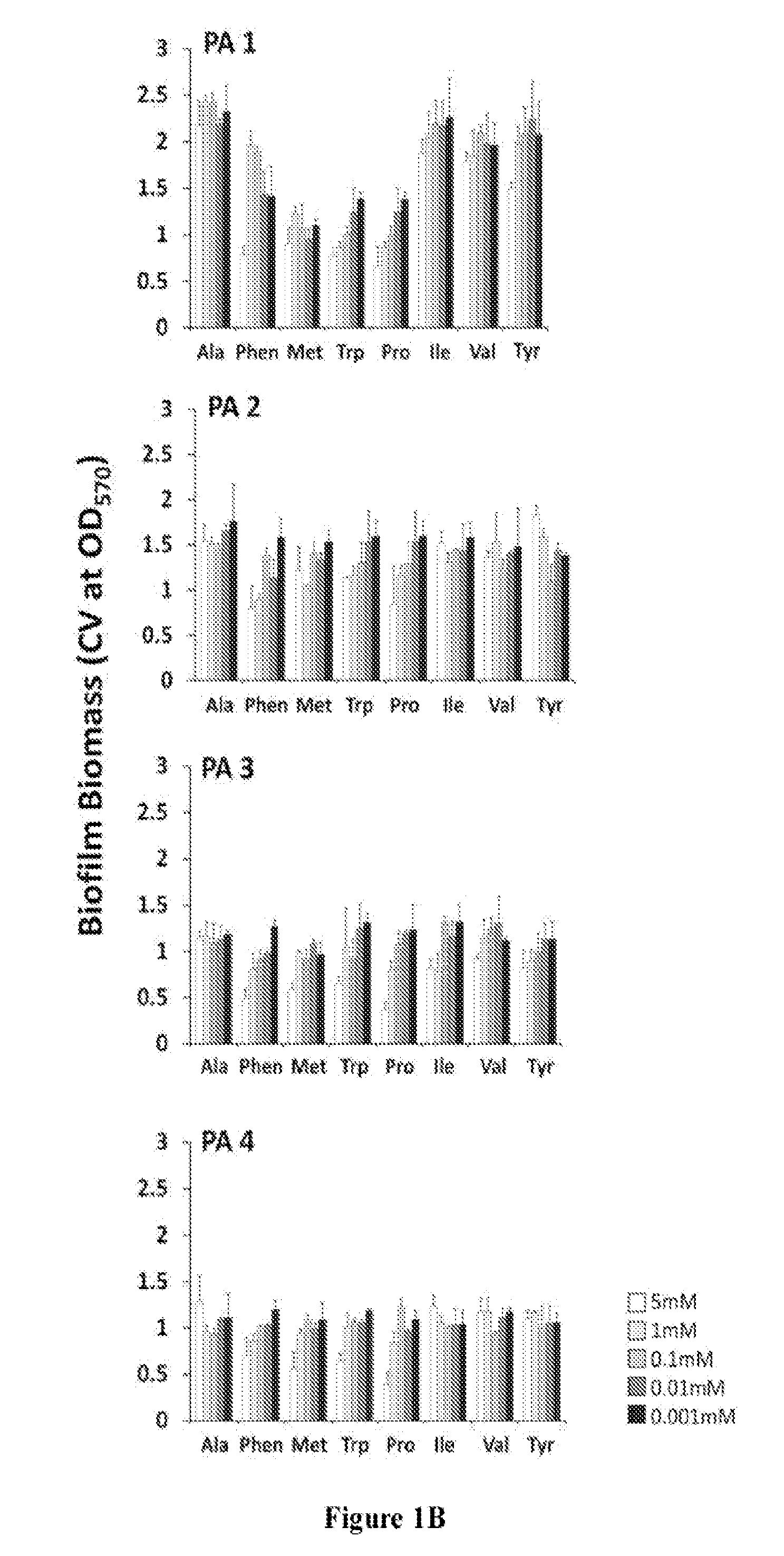Composition with Biofilm Dispersal Agents
a technology of biofilm and dispersal agent, which is applied in the direction of prosthesis, unknown materials, organic active ingredients, etc., can solve the problems of systemic agent toxicity, large majority of remaining bioburden, and difficulty in achieving high concentrations of antimicrobial agents
- Summary
- Abstract
- Description
- Claims
- Application Information
AI Technical Summary
Benefits of technology
Problems solved by technology
Method used
Image
Examples
example 1
[0176]This Example describes methods for preparing polyurethane (PUR) composite comprising D-amino acids, as well as processes for characterizing the effects of PUR comprising D-amino acids on biofilms.
[0177]The clinical strains utilized in this Example were single bacterial isolates collected from patients admitted for treatment at Brooke Army Medical Center / San Antonio Military Medical Center (BAMC / SAMMC; Ft. Sam Houston, Tex.) from 2004-2011, confirmed to be positive for biofilm formation, from the clinical molecular biology laboratory repository (Table 1). Green fluorescent protein (GFP) expressing Staphylococcus aureus stain UAMS-1 and red-fluorescent protein (RFP) expressing Pseudomonas aeruginosa strain PAO1 were also used in this Example. With the exception of S. aureus, which was cultured in tryptic soy broth (TSB), all bacteria were grown in Luria-Bertani broth (LB) at 37° C. with constant aeration. Bacterial cultures were frozen and maintained at −80° C. and sub-cultured ...
example 2
[0189]This Example demonstrates the results obtained from the procedures described in Example 1. This Example also describes the effects of D-amino acids on biofilms. This Example further describes the incorporation of D-AA into PUR composites and characterizes methods of using the PUR composites for treating wounds.
[0190]To evaluate the clinical application of D-amino acids as an antibiofilm strategy, D-AA's ability to disperse and prevent biofilm formation in a panel of clinical isolates of S. aureus and P. aeruginosa was first tested. Pre-screening of a panel of eight D-AAs identified four D-AAs, including D-Phen, D-Met, D-Trp, and D-Pro, to be relatively more effective at dispersing biofilms of S. aureus and P. aeruginosa at 5 mM (FIG. 1). The antibiofilm effect was isoforms specific, as no dispersal activity was observed with L-isoforms of D-AAs. When tested against the panel of clinical isolates of S. aureus and P. aeruginosa, D-Phen, D-Met, D-Trp, and D-Pro, were capable of s...
example 3
[0195]This Example describes procedures conducted to characterize the ability of D-amino acids to disperse and prevent biofilms of strains of S. aureus.
[0196]D-isomers and L-isomers of amino acids (free base form), including alanine, isoleucine, leucine, methionine, phenylalanine, proline, tryptophan, tyrosine, and valine, were obtained (Sigma Aldrich). For use in bacterial and cell cultures, D-AA stocks were prepared by dissolving powders in 0.5 M HCl at concentrations between 150-200 mM. Stocks were then diluted into cation-adjusted Mueller Hinton (MHB-II) broth neutralized to pH 7.4 and stored at −80° C.
[0197]Four clinical isolates of S. aureus from a repository collected from patients admitted for treatment not related to research at the San Antonio Military Medical Center (SAMMC, Ft. Sam Houston, Tex.) were used. Characteristics of four clinical isolates, which were previously confirmed to be positive for biofilm formation, are described in Table 5. UAMS-1 (ATCC strain 49230) ...
PUM
| Property | Measurement | Unit |
|---|---|---|
| physiological temperature | aaaaa | aaaaa |
| porosity | aaaaa | aaaaa |
| porosity | aaaaa | aaaaa |
Abstract
Description
Claims
Application Information
 Login to View More
Login to View More - R&D
- Intellectual Property
- Life Sciences
- Materials
- Tech Scout
- Unparalleled Data Quality
- Higher Quality Content
- 60% Fewer Hallucinations
Browse by: Latest US Patents, China's latest patents, Technical Efficacy Thesaurus, Application Domain, Technology Topic, Popular Technical Reports.
© 2025 PatSnap. All rights reserved.Legal|Privacy policy|Modern Slavery Act Transparency Statement|Sitemap|About US| Contact US: help@patsnap.com



